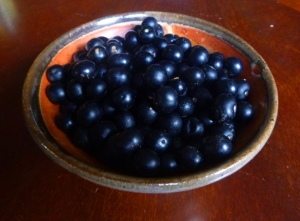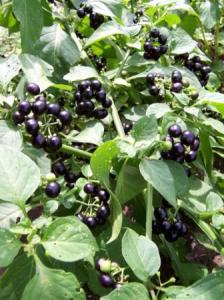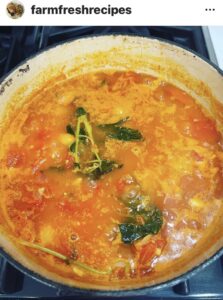
In this week’s box you found huckleberries, a fruit that is actually more related to tomatoes and eggplants than to blueberries and raspberries. There are a variety of wild blueberries that are called huckleberries that grow in more northerly climates, but those are different than the dark purple-black berries you received this week.
These fruits are also known as garden huckleberry, black nightshade, sunberry, and wonderberry. Garden huckleberry is part of the nightshade family, which includes the above mentioned tomato and eggplant, as well as potatoes, peppers, and tomatillos, and the deadly belladona, whose berries look similar to huckleberries but are not in this week’s box. Garden huckleberries are safe to eat, but it is ill-advised to eat unripe huckleberries, which are green in color. There is some discussion about whether you can eat ripe huckleberries raw or not, but our farmers advise that you only eat cooked garden huckleberries. As you may have found out, though these fruits look like blueberries, they taste nothing like them. The thick-skin fruits are full of seeds and juice that is the same dark purple as the skin. They are not sweet and taste slightly similar to a tomatillo. Garden huckleberries are eaten all over the world, as are their greens, yet this fruit isn’t usually found in the supermarket.
Garden huckleberries are commonly used to make pie filling, jams, and sauces. Here is the pie filling recipe that was also shared in this week’s box. This filling can also be served in cobblers, or with yogurt or ice cream.

Garden Huckleberry Pie Filling (2 pies)
5 c. water
1 1/2 c. sugar
2 c. huckleberries
Cook the above ingredients together until huckleberries are soft, approximately 30 minutes.
Then mix together:
3/4 c. cornstarch
1/2 teaspoon salt
1 c. water
Add to cooked huckleberries and cook until thick. Remove from heat and add 1/4 c. lemon juice.
Enjoy! And–if you do try this recipe or any other huckleberry recipes, please let us know how it turns out! You can comment on this post or email megan@fairridgefarms.com. I am going to try to make jam, and will share the results here.
For more information about this old fashioned fruit, here is a great link to in-depth information about huckleberry’s history, usage, and habit.




If they taste like tomatillos, I bet they’d be a fun twist on pork chile verde. Just sub them for the tomatillos.
I used this filling recipe with a crisp topping (oats, flour, butter, brown sugar). I forgot the acid at the end. I didn’t have lemon juice and was going to sub a white peach balsamic, but I was too quick to put it in the pan and get it in the oven. So it was maybe a little sweeter than I would have liked. But it turned out quite tasty. I love trying new things.